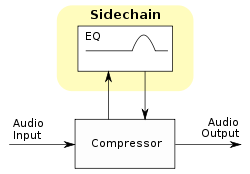De-essing
De-essing is any technique intended to reduce or eliminate the excessive prominence of sibilant consonants, such as "s", "z" and "sh", in recordings of the human voice.[1] Sibilance lies in frequencies anywhere between 2–10 kHz, depending on the individual voice.
Excess sibilance can be caused by compression, microphone choice and technique, and even simply the way a person's mouth anatomy is shaped.
Process of de-essing



De-essing is a dynamic process, only working when the level of the signal in the sibilant range exceeds a set threshold. It differs from equalization, which is a static change in level, but can also be used to reduce the level of sibilant frequencies.
In short, de-essing temporarily reduces the level of high frequency content in the signal when a sibilant sound is present:[1]
Side-chain compression or broadband de-essing
With this technique, the signal feeding the side-chain of a dynamic range compressor is equalized or filtered so that the sibilant frequencies are most prominent. As a result the compressor only reduces the level of the signal when there is a high level of sibilance. This reduces the level over the entire frequency range. Because of this, attack and release times are extremely important, and threshold settings cannot be placed as low as with other types of de-essing techniques without experiencing more blatant sound artifacts.
Split-band compression
Here, the signal is split into two frequency ranges, a range that contains the sibilant frequencies, and a range that does not. The signal containing the sibilant frequencies is sent to a compressor. The other frequency range is not processed. Finally the two frequency ranges are combined back into one signal.
The original signal can either be split into high (sibilant) and low frequencies, or split so that the frequencies both below and above the sibilance are untouched. This technique is similar to multi-band compression.
Dynamic equalization
The gain of a parametric equalizer is reduced as the level of the sibilance increases. The frequency range of the equalizer is centered on the sibilant frequencies.
De-essing with automation
A more recent method of de-essing involves automation of the vocal level in a DAW. Whenever problematic sibilance occurs the level can be set to follow automation curves that are manually drawn in by the user.
This method is made feasible by editing automation points directly, as opposed to programming by manipulating gain sliders in a write-mode. An audio engineer would not be able to react fast enough to precisely reduce and restore vocal levels for the brief duration of sibilants during real-time playback.
References
- Jeffs, Holden, and Bohn, "Dynamics Processors - Chapter 4", in Dynamics Processors -- Technology & Applications, .